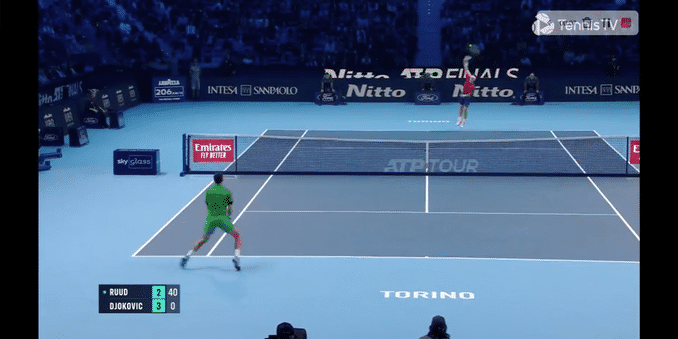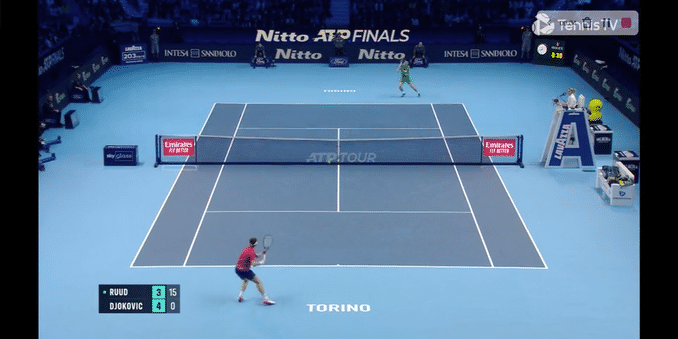Novak Djokovic defeated Casper Ruud 7/5 6/3 to clinch a record-equalling (Federer) sixth ATP Finals title in Turin on Sunday. The Serb went undefeated through the tournament (5-0) and pocketed $4.7m with the win. He also extended his H2H to 4-0 over Ruud.
Ruud
While most pundits would have picked Djokovic to reach the final this week, few would have seen Ruud as the Green group winner and eventual runner-up. Often dismissed as a clay courter, the 23-year-old Norwegian has had an impressive year on the hardcourts:
Miami Masters 1000 final (lost to Alcaraz)
Montreal Masters 1000 semi-finals (lost to Hurkacz)
US Open final (lost to Alcaraz)
ATP Finals final (lost to Djokovic)
While not the most talented or athletically gifted player on tour, Ruud’s game hits many of the technical markers I’ve been writing about here. Notably:
A low serve toss. A quote from a prior piece:
“If I had to summarize the mechanics of great servers…they tend to move the racquet quickly through a lot of space…we see the racquet head maintain or build speed through the backswing (where the racquet moves behind the player’s head). A low toss is the most instinctive way to to create a fast swing.”
The six-foot Ruud has been dominating on serve this year, joining 6’3’’ - 6’10’’ giants and placing in the ATP’s top 10 for serve rating. It’s sneaky quick and hard to read.
Gravity-assisted forehand. From “Death of a Forehand - Part I”:
“…great forehands in recent decades have been of the same ‘modern’ kind, tending to differ by degrees only…while they each have their own style and grip, they all contain two key elements that I believe are necessary for their success. The first is a neutral/extended wrist in the set-up. The second is the use of gravity to start the downswing by pointing the racquet tip up.”

Ruud and Djokovic lead the way in forehand quality.
Ruud’s most recent improvement has been a change in his backhand set-up. I tweeted the change in detail, highlighting his more open strings and higher and fuller take-back; all things you would see in great backhands. If you have a keen eye, note the lower take-back and closed strings back in march in Miami here. That backhand wasn't generating racquet head speed with gravity, but lag, and as a result I felt he was more susceptible to mistiming the ball. The newly tweaked backhand has seen an improvement in his numbers compared to last year’s Finals edition. Shoutout to Matt Willis at
for digging up the round-robin numbers. Ruud's W/UE's last year averaged -7.3. This year? -5.
Notes: Djokovic split-steps left anticipating a crosscourt backhand. You can see Ruud’s racquet setup high and further behind his head with more open strings, rather than around his hips and to the side (R) like he was in Miami. Swinging from the inside means you are more likely to catch the outside of the ball and draw this ball back into the court, rather than slice/fade it wide. The Norweigian was no slouch in TennisTV’s backhand metric either:

A final tactical note. On hard courts Ruud has adopted the Wawrinka-esque return strategy of blocking first serves close to the baseline, then reverting back deep to take big cuts on the second serve with his forehand, which is where he is more comfortable. I don’t have data, but it would be interesting to note how many 1st-serve returns were put in play by all eight guys this week. My hunch is Ruud would have good numbers, and TennisTV ranked him fifth overall this week in return rating. Sure it’s not a dangerous reply, but it’s a great strategy to build pressure.
Patterns and strategies
Ruud likes to play with time and bounce on the forehand. When he has time he can unload with a lot of power and spin and hurt guys from deep positions.

Djokovic did well to continually rush Ruud for time, stepping in to take balls on the rise, and redirecting with brutal and pinpoint precision. Ruud was often never set, having to slice backhands or spin forehands back defensively.

We can see Djokovic was hitting his forehand 10km/h faster than Ruud. He was also hitting from closer to the baseline, so the time difference would have really pressured Ruud.

Groundstroke patterns aside, what has impressed me most about Djokovic this year is how dominant he is on serve. As I’ve touched on previously, Djokovic doesn’t hit a lot of outright winners—he’s not a knockout player—but he absolutely crushes the “make you miss” stats; unreturned serves and forced errors.

Set 2 featured similar patterns and was more dominant from Djokovic’s end. While the official rankings have the Serb in 5th—behind Alcaraz, Nadal, Ruud, and Tsitsipas—the last few months have made it clear that he is still the world’s best player, and he enters 2023 with no points to defend at the Australian Open and Wimbledon. He will almost certainly reclaim the world number 1 ranking next year barring another sidelined stint. Goran Ivanesevic—who has been part of team Djokovic since 2019—made it clear that the Serb is coming for all of it in 23’:
“He's practising even harder than when he was 22. That's why he's still so good and that's why he's still going to be even better,” Ivanisevic said. “The will to practise, the will to improve, the will to be better is amazing…He's still hungry, he's still winning the tournaments, playing unbelievable tennis. He's still already thinking now about preparation for next season.”
“But his serve is one of the best shots which people, they don't talk [about], because they have so many other things, they forget to talk about his serve. He has one of the best serves. Especially when it's tight, it's tough, especially this week he was hitting unbelievable serve under pressure.”
For this newsletter, it’s fitting that the year finished with the two players who exemplify good technique across the board battling it out in the final. While good technique is not an automatic panacea that will take a player to the top (movement, athleticism, desire, mental strength, and good tactics are all necessary) poor technique will undoubtedly leave players exposed despite their best efforts, as I have touched on repeatedly over the course of the year. A reminder of the newsletter’s intention, from the very first post:
“The man who believes that the secrets of the world are forever hidden lives in mystery and fear. Superstition will drag him down. The rain will erode the deeds of his life. But that man who sets himself the task of singling out the thread of order from the tapestry will by the decision alone have taken charge of the world and it is only by such taking charge that he will effect a way to dictate the terms of his own fate.” Cormac McCarthy, Blood Meridian
Great performance has a signal, and the very best are willing to change and adapt to meet the technical and tactical landmarks that reality rewards.
A final note.
A big thanks to the near 600 subscribers we have now. Over the year I’ve had many kind emails, comments, likes, and shares. These small gestures help keep me going, and seeing new subscribers continually roll in is motivating during the inevitable lulls in a year. If I’ve helped you see tennis in a new light, or if you think this newsletter is adding some value, a share or subscription is much appreciated. I’ll continue to post some content during this short off-season, and look forward to getting stuck into more match analyses in 2023.







Found your blog by accident, so am trying to read older content as well. What you have is the most in depth analysis I have seen on major matches, thanks for writing such great content !!
I hope Ruud continues his success next year. It takes humility and guts to change your technique after you've made it to the top. And what a monster Nole is, christ. I used to root against him because I didn't want him to surpass every record Roger set, but fuck it, it's impossible not to love the guy. Right now I'm just grateful that I can watch him play. Great analysis, as usual. Your writeups have bettered my understanding of the game. I used to train hard but always in groups, so I didn't get much specialized technique training, it was mostly fitness and matchplay. Your blog has motivated me to take some time off from matches and work on my technique.